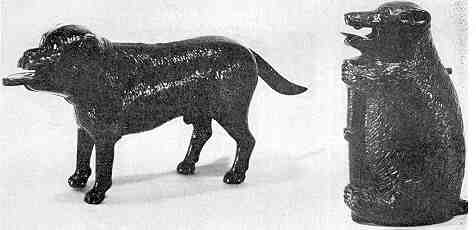Bull Dog Standing - - - - Bear and Tree Stump
by F.H. Griffith - HOBBIES Magazine - March, 1966

Two animal mechanical banks, a dog and a bear, each made by the same concern, H.L. Judd Company of Wallingford, Conn., are our choice as Nos. 141 and 142 in the numerical classification. These are what we might call "simple action" banks, as were most of those manufactured by Judd. They produced a nice line of good banks over a period of years, but none were particularly outstanding or highly animated. Unfortunately, this simplicity of construction and mechanism made a number of their banks prime targets for recasting, including the two under present discussion. Actually original specimens of the Bull Dog Standing or the Bear And Tree Stump are not plentiful or easy to come by. This has become increasingly so as the years have passed since mechanical banks first became collectors items. The recasts that have been made of the various Judd banks can be recognized as such, and for further detail on this situation please refer to the April, 1963, article in HOBBIES on the Bucking Mule Bank. This was the first of the Judd banks to be covered in the series of articles.
The general line of Judd banks were made with good detail in their casting. Hair lines, for example, were well done with fine definition, and both the Bull Dog Standing and Bear And Tree Stump are representative of this. Their banks were usually painted in one of a number of basic colors. Judd listed these colors as Ebony or Ebonized, Bronzed, Copper Bronze, Maroon, Gilded, and Dark Antique Finish. Thus none of their banks are particularly colorful, although a touch of red and yellow was used on the Bucking Mule and several others. In some cases certain of their banks were painted in combinations of two of their basic colors. The various basic colors, by the way, were in a japanned type finish. With the possible exception of the Mosque Bank, all other Judd production banks were comparatively small in size and only small coins—pennies, dimes and nickels—could be used in their operation. Most of their banks were made in two half-sections with no coin traps, making it necessary to take the respective bank apart in order to remove accumulated coins.
In spite of the fact that this is only the second time Judd banks have appeared in this series of articles to date, they, as a mechanical bank manufacturer, are among the top ten companies who made mechanical banks in the United States. They were quite active in this field during their period.
The Bull Dog Standing shown, Fig. 1, is a fine original specimen with the ebony or ebonized type finish. The only other color on this bank are the two white eyes of the dog. The operation of the bank is simplicity itself. A coin is placed on the dog’s tongue and his tail is then lifted. This causes the tongue to recede into the dog’s mouth and the coin drops from there inside the bank. The tongue in receding tilts to the side as it goes inside the dog and the coin slides therefrom. The weight of the tail, when released, returns the tongue to the position as shown in the picture. A fine illustration of this bank appears in the 1887 catalog of C.F. Rice, Chicago, Ill. They priced it at 20c each.
The Bear And Tree Stump is pictured in Figure 2 and it also is a fine original specimen with the ebony or ebonized type paint. The only other color is the red tongue of the bear. To operate the bank a coin is placed on the tongue of the bear and a lever in his back is then depressed. This causes the tongue to lift up and the coin slides on inside the body of the bear. The tongue returns by its own weight to the position shown in the picture. A fine illustration of this bank also appears in the same 1887 Rice catalog and it was priced at 25c each.
In closing it bears mention that most of the Judd banks have more appeal to the advanced collector rather than the beginner. They are not spectacular nor colorful and action is limited. This, however, does not detract from their being desirable additions to a collection.
